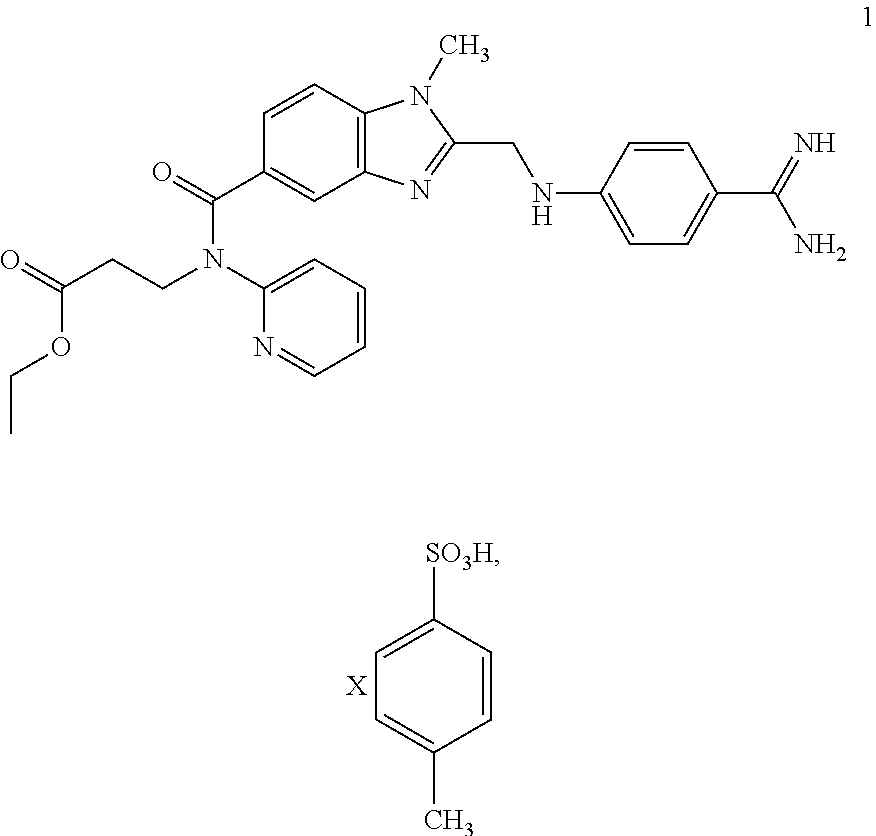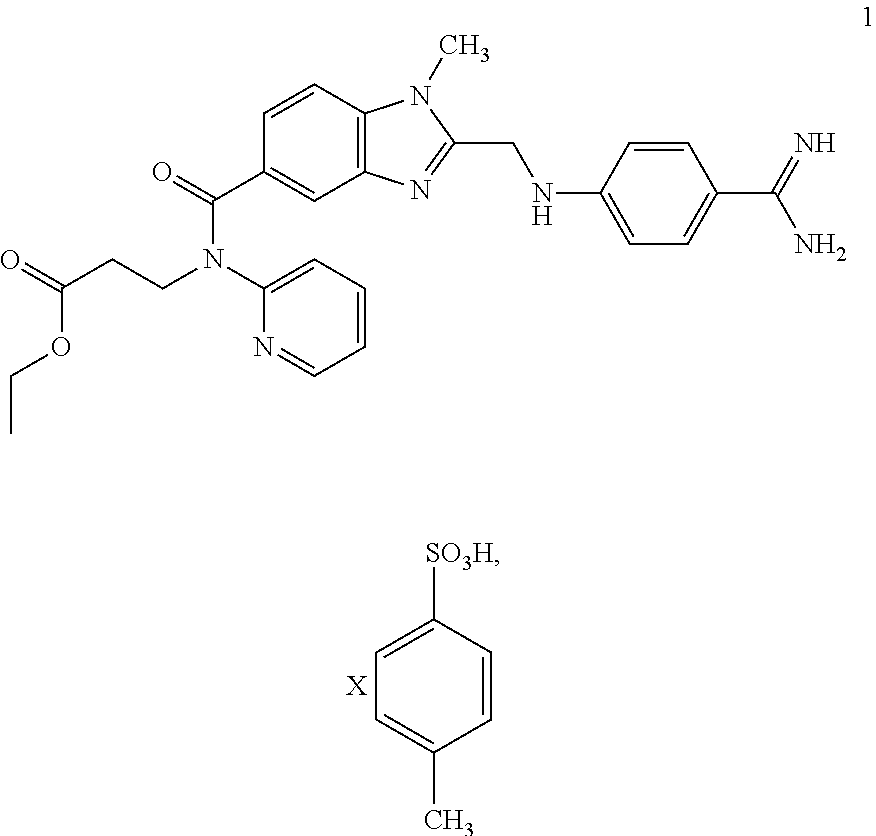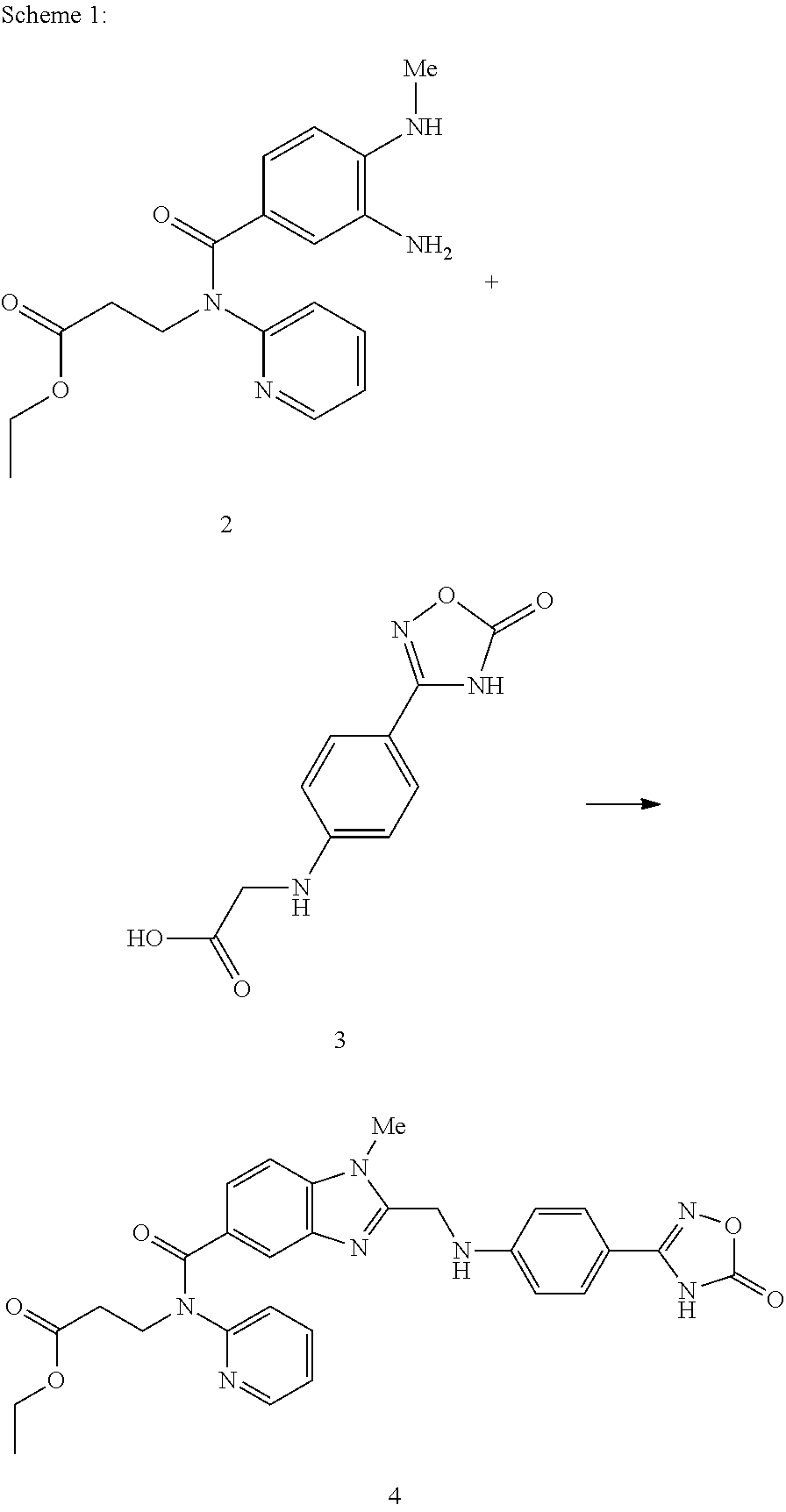Method for producing an intermediate product of dabigatran etexilate
a technology of dabigatran etexilate and intermediate products, which is applied in the direction of organic chemistry, etc., can solve the problems of high yield loss, high acid load, and high cost of isolation and drying of intermediates,
- Summary
- Abstract
- Description
- Claims
- Application Information
AI Technical Summary
Benefits of technology
Problems solved by technology
Method used
Image
Examples
example 1
[0042]24.20 g of 2 and 19.95 g of 3 are largely dissolved in 100 ml THF at approx. 30° C. 24.92 g of DIPEA are then added at this temperature. Then 57.89 g of a 50% solution of PPA in THF are metered in at RT and the mixture is stirred for approx. 2 h.
[0043]After the addition of 13.44 g of citric acid and 20 ml THF, condensation is carried out at approx. 90° C. under pressure to obtain the non-isolated intermediate 4. After the reaction has taken place the reaction mixture is cooled to RT and combined with 1.21 g of water-moistened 10% Pd / C and 100 ml of water. Then the suspension is heated to approx. 50° C. and hydrogenated under a hydrogen atmosphere (at approx. 4 bar).
[0044]Pd / C is filtered off and washed with 25 ml of water. After the addition of 25 ml of water the reaction mixture is combined at approx. 50° C. with 20.40 g of a 65% aqueous PTSA solution and 60 ml of a 25% aqueous ammonia solution. The tosylate begins to precipitate out. It is cooled to RT, the product 1 is filt...
example 2
[0047]24.20 g of 2 and 19.95 g of 3 are largely dissolved in 87 ml THF at RT. At this temperature 24.92 g of DIPEA are then added. Then at RT 57.89 g of a 50% solution of PPA in THF are metered in, rinsed with 13 ml THF and stirred for approx. 2 h. After the addition of 6.72 g of citric acid and 20 ml THF condensation to obtain the non-isolated intermediate 4 is carried out at approx. 90° C. under pressure. After the reaction has taken place the reaction mixture is cooled to RT and combined with 1.24 g of water-moistened 10% Pd / C and 60 ml of water. Then the suspension is heated to approx. 50° C. and hydrogenated under a hydrogen atmosphere (at approx. 4 bar).
[0048]Pd / C is filtered off and washed with 50 ml of a THF-water mixture (7:3). After the addition of 20 ml of a THF-water mixture (7:3) the reaction mixture is combined at approx. 50° C. with 39.93 g of solid PTSA and 60 ml of a 25% aqueous ammonia solution. The tosylate begins to precipitate out. It is cooled to RT, the produc...
example 3
[0051]24.20 g of 2 and 19.95 g of 3 are largely dissolved in 87 ml THF at RT. At this temperature 24.92 g of DIPEA are then added. Then at RT 57.89 g of a 50% solution of PPA in EtOAc are metered in, rinsed with 13 ml THF and stirred for approx. 2 h. After the addition of 6.72 g of citric acid and 20 ml THF condensation to obtain the non-isolated intermediate BIBR 1048 oxa-amidine is carried out at approx. 90° C. under pressure. After the reaction has taken place the reaction mixture is cooled to RT and combined with 1.21 g of water-moistened 10% Pd / C and 75 ml of water. Then the suspension is heated to approx. 50° C. and hydrogenated under a hydrogen atmosphere (at approx. 4 bar).
[0052]Pd / C is filtered off and washed with 50 ml of a THF-water mixture (1:1). After the addition of 25 ml THF and 10 ml of water the reaction mixture is combined at approx. 50° C. with 39.93 g of solid PTSA and 60 ml of a 25% aqueous ammonia solution. The tosylate begins to precipitate out. It is cooled t...
PUM
| Property | Measurement | Unit |
|---|---|---|
| temperature | aaaaa | aaaaa |
| temperature | aaaaa | aaaaa |
| temperature | aaaaa | aaaaa |
Abstract
Description
Claims
Application Information
 Login to View More
Login to View More - R&D
- Intellectual Property
- Life Sciences
- Materials
- Tech Scout
- Unparalleled Data Quality
- Higher Quality Content
- 60% Fewer Hallucinations
Browse by: Latest US Patents, China's latest patents, Technical Efficacy Thesaurus, Application Domain, Technology Topic, Popular Technical Reports.
© 2025 PatSnap. All rights reserved.Legal|Privacy policy|Modern Slavery Act Transparency Statement|Sitemap|About US| Contact US: help@patsnap.com



